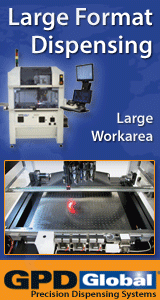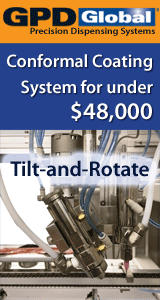sree, You might want to check the archives. If not, I found this just a few questions below yours!!
[Back to thread listing at top] Posted by Igmar on June 22, 2000 at 10:27:26 AM EST
Can someone please help with the aperture size on a Micro BGA stencil. I want to have an electroformed stencil made with 0.1mm (4mil) thickness. The PCB pad for the micro BGA has a 0.406mm (16mil) diameter. What size should I make the apertures for the BGA. I will be printing with a metal squeegee. Thanks for any advice. [ Post a Followup ]
[Back to thread listing at top] Posted by Dave F on June 23, 2000 at 9:54:20 AM EST
Igmar: Chrys and JAX make good points. I'd like to add that you should be careful that you don't starve larger chip components of solder when using a 4 thou stencil. [ Post a Followup ]
[Back to thread listing at top] Posted by Chrys Shea on June 22, 2000 at 11:21:59 AM EST
My personal opinion:
Use 20 mil squares with the corners radiused at 5 mils.
The squares offer 2 benefits: 1) A little more paste, which makes for a higher diameter solder column that is more reliable 2) Better stencil release of the paste. It's easier to print squares than circles, because as the paste peels out of the apertures, the corners give it a starting point. Rounding the corners makes it robust against paste sticking in the tight vertices.
Just an opinion based on experience and reading. Can't cite a study to reference.
Chrys
[ Post a Followup ]
[Back to thread listing at top] Posted by JAX on June 22, 2000 at 12:50:13 PM EST
Igmar, Although I agree with Chrys that square is good,( Better volumn ) his explanation is not entirely correct. Heres a little insert from automata: With square apertures, solder paste is deposited at the center of the aperture. The center releases first from the PCB, because the velocity profile is highest at the center of the aperture. Then, the solder paste at the midpoint of each side of the aperture releases, because they are high stress points. At the corners of the aperture, the paste does not readily release due to their narrow radii. The attracting force from the surface tension of the solder paste pulls the solder paste toward the center of the apertures. Depends upon the uniformity of the print and the shear stress from the stencil wall, the solder paste at the corner could release or adhere to the stencil. Even with the irregularity in average paste volumn it will still provide more than round apertures. More is Better! That's just my opinion, I could be wrong!!!
reply »
![]() What is the best aperture opening for micrBGA with 0.8 mm b...
- Jun 29, 2000
by
What is the best aperture opening for micrBGA with 0.8 mm b...
- Jun 29, 2000
by
![]()
![]()
![]() sree,
You might want to check the archives. If not, I found...
- Jun 29, 2000
by
JAX
sree,
You might want to check the archives. If not, I found...
- Jun 29, 2000
by
JAX
![]()
![]() Hi Jax,
The microbga discussed earlier in the forum is moun...
- Jun 29, 2000
by
Hi Jax,
The microbga discussed earlier in the forum is moun...
- Jun 29, 2000
by
![]()
![]()
![]() sree,
There is no Definite. You have to make the call. If y...
- Jun 29, 2000
by
JAX
sree,
There is no Definite. You have to make the call. If y...
- Jun 29, 2000
by
JAX
![]()
![]() That pad had a 16 mil dia, so I arrived at 20 mil squares b...
- Jun 30, 2000
by
Chrys
That pad had a 16 mil dia, so I arrived at 20 mil squares b...
- Jun 30, 2000
by
Chrys
![]()







